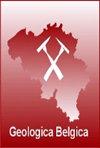Frasnian reef mounds in the Durbuy–Bomal area (eastern border of the Dinant Synclinorium, Belgium)
IF 0.7
4区 地球科学
Q2 GEOLOGY
引用次数: 0
Abstract
This paper focuses on the Frasnian reefal development in the eastern border of the Dinant Synclinorium. Classical sections from the Durbuy–Bomal area were reevaluated for lithostratigraphy, microfacies, magnetic susceptibility (MS) and diagenesis. As regards the middle Frasnian succession, the studied area is located in a transitional zone between the Pont de la Folle/Philippeville Formations and the Moulin Liénaux/Grand Breux Formations. This succession is topped by Petit-Mont Member reef mounds. Massive mound microfacies are characteristic of the Petit-Mont and Lion Members, with fossil associations respectively dominated (from deepest to shallowest) by sponges; sponges, crinoids and corals; corals, crinoids, stromatoporoids and cyanobacteria; and microbes. Flank and off-mound microfacies consist of microbioclastic, bioclastic, crinoidal or lithoclastic bedded limestones. MS values are related to the depositional environment and regularly decrease from the off-mound to the reef mound microfacies. The reef mound diagenetic sequence is similar to that identified in other Petit-Mont buildups: cementation in the marine phreatic zone preliminary to drowning, then the development of a meteoric lens at the time of a marine regression, with dysoxic facies in the distal zones of the aquifer and, finally burial cementation and dolomitization during the Variscan tectonism.Durbuy-Bomal地区的Frasnian礁丘(比利时Dinant向斜的东部边界)
本文重点研究了迪南特向斜东缘的弗拉斯尼礁发育。对Durbuy-Bomal地区的经典剖面进行了岩石地层、微相、磁化率和成岩作用的重新评价。关于中弗拉斯纪演替,所研究的地区位于Pont de la Folle/Philippeville组和Moulin limassnaux组/Grand Breux组之间的过渡地带。这个演替序列的顶端是小蒙特·梅伯尔礁丘。块状丘微相以小山段和狮子段为特征,化石组合从最深到最浅分别以海绵为主;海绵、海百合及珊瑚;珊瑚、海百合、层孔虫和蓝藻;和微生物。坡侧微相和坡下微相由微生物碎屑岩、生物碎屑岩、海泥岩或岩屑层状灰岩组成。MS值与沉积环境有关,从下坡微相到礁丘微相有规律地递减。该礁丘的成岩序列与其他小山构造相似:在海洋潜水带早期发生胶结作用,然后在海洋退缩时形成一个大气透镜体,在含水层的远端发育欠氧相,最后在瓦利斯卡构造运动期间发生埋藏胶结作用和白云化作用。
本文章由计算机程序翻译,如有差异,请以英文原文为准。
求助全文
约1分钟内获得全文
求助全文
来源期刊

Geologica Belgica
地学-地质学
CiteScore
4.70
自引率
27.80%
发文量
8
审稿时长
>12 weeks
期刊介绍:
Geologica Belgica is a Belgian journal that welcomes papers concerning all aspects of the earth sciences, with a particular emphasis on the regional geology of Belgium, North West Europe and central Africa. Papers not dedicated to the geology of Belgium, North West Europe and central Africa are only accepted when one of the authors is linked to a Belgian University or Institution. Thematic issues are highly appreciated. In this case, guest editors take in charge the selection of the manuscripts and the subject of the papers can be enlarged. The journal is in open access.
Submitted manuscripts should be concise, presenting material not previously published. The journal also encourages the publication of papers from Belgian junior authors. Short letters are accepted. Papers written in English are preferred. Each mansucript will be reviewed by at least two reviewers.
 求助内容:
求助内容: 应助结果提醒方式:
应助结果提醒方式:


